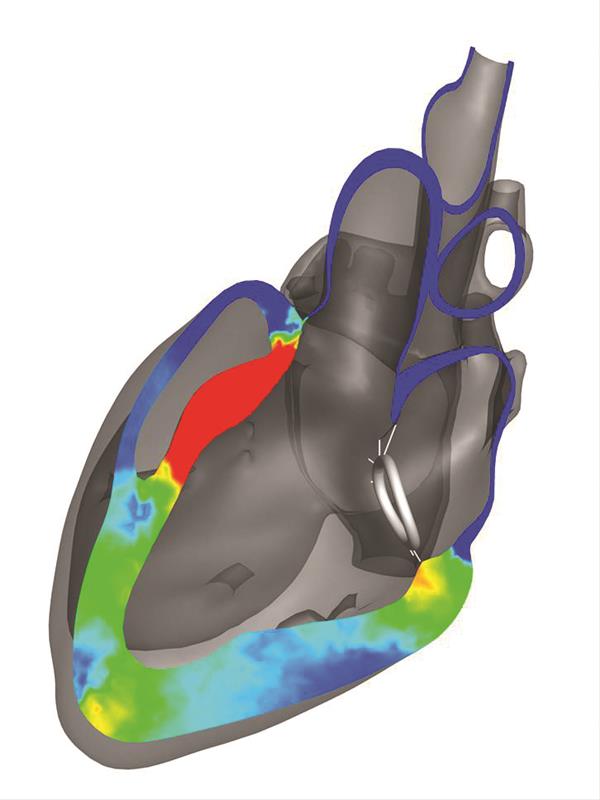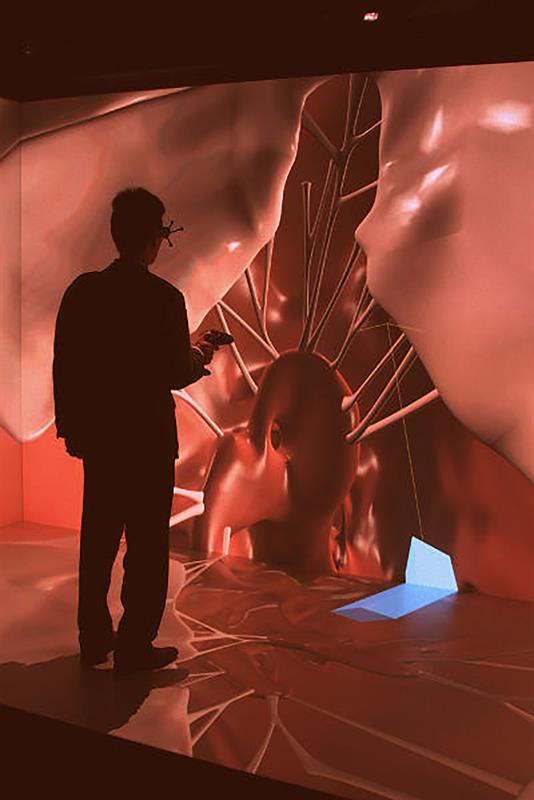Some industries have long since embraced simulation as an essential part of the design process, particularly those that require knowledge of stresses or fluid flow. For some simulation is an unnecessary level of complexity, but for others again the complexity stretches the capabilities of simulation software to the limit.
The human heart comes into this last category. It is incredibly complex and is unique to every individual. In fact there are trials underway to use the heart’s signature as a form of identity check for such uses as banking, making passwords a thing of the past. Simulating a heart therefore has to accommodate unlimited variations.
The Living Heart Project was launched by Dassault Systemes to attempt, for the first time, to produce a realistic working 3D model of the human heart. Armed with such a personalised model, the argument goes, diagnosing, treating and preventing heart conditions can be tackled far more effectively.
The model has been built in Simulia, Dassault Systemes simulation suite, which provides engineers with a method to test their designs, to do predictive analysis and assess durability.
April Alfieri of the company’s Virtual Human Modelling team outlined the objective: “We launched the Living Heart project in 2014 with the idea of somehow revolutionising cardiovascular care through realistic simulation. Today realistic simulation isn't used widely in cardiovascular care and we wanted to do something about it.”
With such a tool at the fingertips of cardiac device and services companies, the ability to effectively see the working heart will help in exploring the design space, refining ideas faster, and developing novel service solutions that are more effective and safer for patients. All of which leads to better designs and a reduction in expensive prototyping and testing, allowing companies to get products and services to market faster.
Clearly Simulia’s expertise lies in simulation rather than cardiovascular care, so it partnered with a host of interested parties in order to tackle both clinical and commercial demands. Partners included clinicians, regulatory bodies like the FDA and MDIC (Medical Device Innovation Consortium), researchers and medical device companies.
“With our Living Heart model,” continued Alfieri, “a design engineer and a medical device designer will be able to design, say, a stent and then take that stent design, create an FEA model and bring it into the heart model, and use Simulia products to test the effectiveness of the stent design.”
Introducing medical conditions into the model will come but in the first instance the objective has been to create a model of a healthy heart. “The heart is very complex,” said Alfieri. “Not only in its structure, but also it's got a lot of physics, the fluid flow physics, and physiology physics too. So it was a very challenging engineering problem for us to build this model. Ultimately our end goal is to create personalised models and a method for rapid creation of those models.”
Technically speaking the first model is a personalised model as it was created using MRI and CT scans from a healthy male in his late 40s. This information was used to create a geometric model, which in turn was used to create an FEA model that facilitates simulation.
Having a personalised model for each patient will allow cardiologists and surgeons to test and do pre-surgical planning and training. For example, if a valve replacement operation was being planned, instead of opening up the patient during surgery and then trying to fit the valves in, it could be done virtually before cutting the patient open. Theoretically surgery should become quicker, and outcomes better.

Living Heart graphic showing medical device analysis
But it is not just a tool for the surgeon, it is very much a tool for the design engineer too. “Definitely for both,” said Brian Baillargeon, technical lead at Simulia Virtual Human Modeling . “Aortic stenosis. Mitral valve regurgitation. These conditions are of interest to the design engineers and they're probably the ones that are going to use it first, because they're actually already using our tools to design the devices and simulate the devices. Now we can embed the devices in a more realistic environment to test them. You can see your device design inside a beating heart – a dynamic heart – and see how it behaves.”
The range of devices could include such items as a catheter in place, a stent, or a valve replacement. Since the launch of the initial model in May 2015, the heart has already been successfully used to evaluate the function of a new annuloplasty ring design, predict pacemaker lead stresses, model disease progression and one member has received a CE Mark in Europe for a service using simulation to perform virtual transcatheter aortic valve replacement sizing.
The Living Heart is the first commercial-grade four-chamber heart model and it is hoped it is going to provide more insightful results than previous attempts that may have just had part of the heart modelled. “For each new, unique use case, validation has to be done,” said Baillargeon. “It's an ongoing process for validation, depending on what the heart's being used for. It's a general-purpose platform, so it's going to be a continual process to validate all the specific use cases that it could be potentially used for.”
Another issue, that has taken the expertise of project partners to resolve, has been to calibrate the material behaviour – how stiff it is and how much it contracts. “There's particular MRI scans you can do to get what the strains are on the heart and we have used that on the model, along with haemodynamic studies,” said Baillargeon.
The team have been able to marry up the electrical stimulus, resulting in excitation of the hearts tissue and then contraction, simulating the full working system of the heart.
The consequence is a system that may not only improve existing medical processes, but may result in new ones being developed. Baillargeon continued to explain: “We're going to have areas where you have a specific device for reading, say mitral valve regurgitation. If the mitral valve is leaky, that can actually cause heart failure if it's really severe. So we might create a model that simulates that, and then the designers will build devices that treat it. But then we also gain fundamental insights to the heart. A lot of times we might say, ‘a specific disease state’. Well now we can come up with a completely new procedure or technique to actually repair that and treat it in some way.”
The key to the project has been the power of the software and the commitment of the partners. “We need the software to actually solve these types of problems - the investment in technology that Dassault has done has really allowed us to get this far,” said Baillargeon. “But the cardiovascular expertise came from the Living Heart project. It's a unique collaboration between all these individuals that really share their knowledge with us. Basically, a certain person knew a lot about electrophysiology, a certain person knew about left ventricular functions, a certain person knows about this, a certain person knows about that. We take all that data, we combine it all together and we have a unified platform for everybody to use.”
One of the partners is Materialise. The company’s product engineer of cardiovascular, Julie Maes, commented: “The Living Heart project has the mission to develop and validate highly accurate personalised digital models of the human heart. To achieve this, it is essential to represent the shape of the anatomy with high accuracy. Materialise has substantial expertise in converting medical images to detailed 3D models that can then be used for various applications such as finite element modelling. One of the priorities for the Living Heart project is to have an accurate representation of the essential details combined with a high mesh quality.
“We hope that the valuable 3D information provided by the medical images will be brought to the next level by the Living Heart project, in both the development of new devices as well as in pre-operative planning.”
 'A real-time test bed'
'A real-time test bed'
Department head of Philips Research in France, another of the partners, is Nicolas Villain who sees the project as a major facilitator in the development of standardised and reproducible image-based measurements of the cardiac function. Villain commented: “Never before have we been able to effectively use the heart as a real-time test bed. Such is the complexity of the heart as an engineering system that it is impossible to have realistic physical phantoms to test our imaging systems. This is a real limitation for calibrating and standardising image-based measurements that can help cardiologists in understanding the condition of the patient’s heart and better quantify its evolution under treatment. The Living Heart model gives us the opportunity to simulate the complex cardiac motion, driven by an accurate model of the cardiac anatomy and physiology, in a fully controlled environment, which is key to develop and validate our diagnostic solutions.
“The Living Heart project has opened up a new level of simulation and it is also a collaborative model where all the partners bring their expertise in. Through medical imaging of the heart, we can extract a lot of information about the anatomical variants and normal or pathological motion patterns. Our dream is to enable the model to capture all this variability, so that personalised treatments and custom-fitted devices can be designed and delivered.”
The relationship between Dassault Systemes and the partners on the Living Heart project is a symbiotic one. The collaborators are doing research in this area and can use the model to help them do that. But they also provide the information back so that the model can be enhanced. Baillargeon added: “There is benefit on both sides.”





